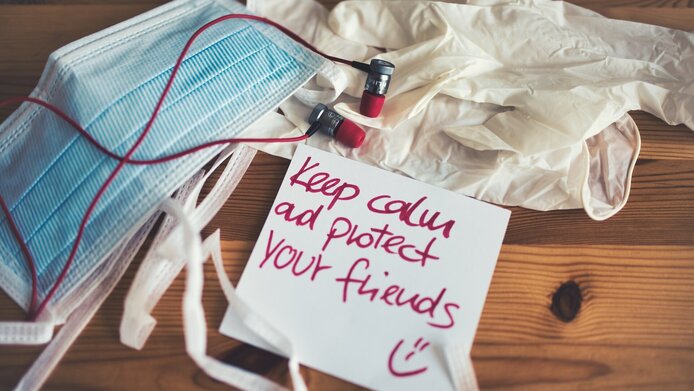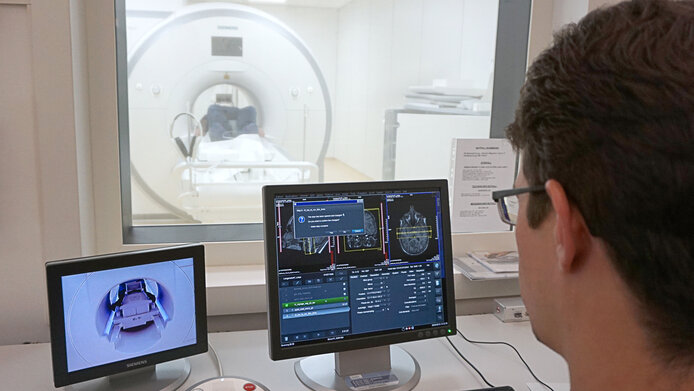Does stress make us more helpful?

Until the beginning of March, friendly gestures such as shaking hands, patting each other on the shoulder or hugging each other were completely normal in Austria. Within a very short period of time, this “social norm”, i.e. social behaviour which society had agreed upon, had to be replaced by self-isolation and other forms of social distancing. The restrictions are designed to slow down the spread of the coronavirus and protect particularly vulnerable population strata from infection. “Current developments show how quickly social norms adapt to challenges and how dynamic and fluid they are,” explains Claus Lamm, who heads the “Social, Cognitive and Affective Neuroscience Unit” (SCAN Unit) at the University of Vienna. This rapid change does raise a number of questions, especially with regard to the lockdown: how do people react to such exceptional situations? What are their thoughts? How do they feel? How do they assess risks, and how do they behave? In a project funded by the Austrian Science Fund FWF, Lamm, a neuroscientist who focuses on social emotional processes, has joined forces with Christian Ruff from the University of Zurich to investigate how stress affects our social behaviour, i.e. how we treat other people in stressful situations.
What defines our social behaviour?
Although stress is a very well studied phenomenon, there has been little research on its impact on social behaviour. This aspect was addressed late, first in 2000 by the renowned social psychologist Shelley E. Taylor from the University of California. Taylor, an expert in social cognition, questioned the established evolutionary biological model which claims that an individual under stress reacts only by fight or flight and put forward a new hypothesis: according to the "tend and befriend” theory, stressful situations induce us particularly to seek contact with people who support us in order to form alliances. This is the result of the adaptation reaction in both the body and the brain triggered by stress. The entire organism is activated to enable it to cope with the extra strain. Lamm’s research partner Ruff divided the various cognitive affective processes underpinning our social behaviour into three categories: “social motivation”, “social cognition” and “conformity with social norms”. Taylor's hypothesis together with the empirical tests formed the basis for the current transnational FWF project. “We want to gain a better understanding of which areas of the brain work together and how. Our main focus is on the route from the stress factor to the brain and on to social behaviour,” explains Lamm.
No thinking without emotions
The researchers consider thinking, feeling and the bodily reaction to emotions as a single unit. Lamm uses the current corona crisis as an example to explain that thinking always involves an emotional response: “It is not possible to think about the exponential growth of the number of people infected with the virus without an emotional component. In cognitive terms we can imagine the curve going up, a process which involves activity in areas of the parietal and prefrontal cortex that have to do with (numerical) thinking and understanding. But at the same time we are able to picture the situation at an emotional level, i.e. we automatically imagine the consequences for all of our lives or for ourselves.” Every emotion also triggers a physical reaction, which is represented in the brain in structures such as the insular cortex and the amygdala. From an evolutionary perspective, emotions serve to push the organism out of a situation. Emotion is transformed into motivation, which makes it a pivotal driving force for our behaviour. “Since humans are highly social beings, we take into account not only these individual processes but also the social context in which they take place,” explains Lamm.
Does giving depend on effort or not?
Let’s come back to the “tend and befriend” theory, which says that people tend to show pro-social behaviour under stress. There are simulations to investigate this effect empirically, but according to Lamm they have some weaknesses. One of them is the failure to take the factor of effort into account. In everyday situations, however, this factor plays a decisive role. To date, the fact that people are willing to give something to others under stress has mostly been shown in games from the field of behavioural economics (e.g. ultimatum, dictator game). Since the act of giving does not involve an effort in this case, the research team is asking whether prosocial behaviour really increases under stress or whether, and this is their assumption, this depends on the amount of effort involved. “If I am stressed by working under a deadline and a colleague asks me to take a quick look at his text, this act requires some effort on my part. If he asks me whether he can take half of my printer paper, of which I have enough, that does not involve an effort, nor does it restrict the resources I need at that moment. It is our hypothesis, therefore, that people under stress show less prosocial behaviour if it involves any effort.” In order to investigate this issue adequately and comprehensively, the researchers are bundling the competences available in the two laboratories in Vienna and Zurich.
Effort and everyday stress as close to reality as possible
In order to measure stress, the researchers rely on the “Montreal Imaging Stress Task” (MIST): acute stress is generated by having test subjects solve mathematical tasks that become increasingly difficult or even impossible to solve. This in itself would, however, not take account of the social assessment aspect, which is an important stressor. “In our studies we have taken this into account by adding social comparison. While people are solving tasks, they are being told that they are doing worse than others,” says Lamm. A total of 120 individuals (all from one age group) have participated in the studies so far, and the measurements take several hours per person. The researchers record neuronal processes using functional magnetic resonance imaging (fMRI) and evaluate these data.
The mathematical tasks are followed by a behavioural economics game in which the participants are asked to divide a certain amount of money between themselves and someone else. Lamm uses a grip force transducer to test whether the willingness to share more fairly increases under stress or whether it depends on the effort involved. In order to give away money, the test person has to press the device – the higher the amount, the more force is required. This setup enables the researchers, who are supported by a team consisting of postdoc Paul Forbes and students and research assistants, to make distinctions: what does “tend-and-befriend” look like in case of little or much effort? Does the motivation come from within, or do people expect some sort of reward for giving? By shedding light on cognitive, affective and normative processes, the researchers set out to understand how social behaviour develops and what processes are involved.
Online survey on the effects of corona
The researchers themselves were also held back by the corona pandemic. “We would have finished collecting data for the first study by mid-March. But without a complete data set, we cannot evaluate the material at this point,” Lamm says regretfully. While he lacks interim results, he does see many related points of interest in the global corona crisis, such as the effect of stress on addictive behaviour. The team are planning to complement their research by quickly launching an online survey on social behaviour in order to gain valuable insights from the experience of the current pandemic.
Personal details Claus Lamm is a biological psychologist who investigates the biological basis of psychological phenomena. His area of special expertise, social cognitive neuroscience, is a young discipline, and the term has yet to be established in the German-speaking world. At the University of Vienna he heads the “Social, Cognitive and Affective Neuroscience Unit” (SCAN) at the Department of Basic Psychological Research and Research Methods.
Publications






